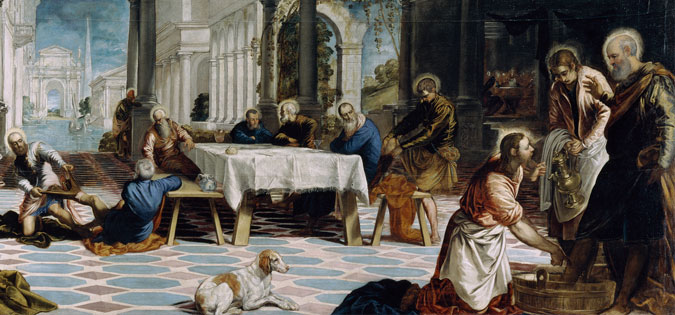 As we move from Lent to Easter, we’ll provide Ignatian prayers for the Triduum, inspired by videos from Arts & Faith: Lent. The video and prayer for Holy Thursday are based on John 13:1–15. The art is Tintoretto’s “Christ Washing the Disciples’ Feet.”
As we move from Lent to Easter, we’ll provide Ignatian prayers for the Triduum, inspired by videos from Arts & Faith: Lent. The video and prayer for Holy Thursday are based on John 13:1–15. The art is Tintoretto’s “Christ Washing the Disciples’ Feet.”
Jesus, knowing that the Father had given all things into his hands, and that he had come from God and was going to God, got up from the table, took off his outer robe, and tied a towel around himself. Then he poured water into a basin and began to wash the disciples’ feet and to wipe them with the towel that was tied around him.
—John 13:3–5
Preparation
The union in openness of body and mind and heart that is prayer begins with attention to each.
First your body: Sit upright, legs crossed or not, feet on the floor or not, lower back pressed against the chair. Or not. Breathe.
Now the mind: As you are able, let these words spill through the mind and down your spine into the earth. Let your thoughts puff away with each breath. As new ones come—knotted as they are with joy or pain—hold them like wounded birds. Set them aside to heal. Breathe.
And the heart: Vulnerability means able to be wounded. Of course there is resistance. Notice it. With your breath and with energy, pull back the vines and push open the gates. Breathe.
Tilt your chin up to the heavens and, with eyes open or closed, look back at the One who gazes at you with great affection.
Breathe.
A Reverence That Leads to Service
In the opening meditation of the Spiritual Exercises, the Principle and Foundation, Ignatius writes: “Human beings are created to praise, reverence, and serve God our Lord.” The opening of the Triduum this Holy Thursday shows us exactly what is meant by a reverence that leads to service. It means rising, trusting, divesting, and serving.
- Imagine yourself at the table with Jesus in the upper room. What food has been laid out? With whom are you sitting? Are you near or far from Jesus? How does room feel—relaxed or jovial or quiet or tense? How do you feel?
- How do you react as Jesus rises from the table?
- Can you tell what is happening in his heart as he stands? How does he feel? Does he want to serve?
- In Tintoretto’s painting, Jesus’ outer garments lay near his feet. What is he removing in preparation for this service?
- How do you feel as he ties the towel and pours the water? What is moving in his heart?
To serve is to lay aside one’s own good to prioritize the good of another. To serve is to place another above ourselves, to say with our mouths and our bodies: you take precedence.
- Does Jesus kneel at your feet?
- How does it feel to have the great friend kneel before you and ask to serve you?
- Can you let him? What arises in your heart? Is it easy to say yes and take the sandals from your feet? Or is there a sliver of Peter’s heart in yours?
- What do you say about it being easy or hard to receive his service?
Genuine consolation, genuine union in joy with the loved one, always moves the lover into service for the loved one—which means that genuine service happens only within the equality that is friendship. This is a service that creates not debtors but peers.
This is what loving us “to the end” means: to love us into his friendship, so that we are no longer servants, but friends.
- Who in your life loves or has loved you to the end?
- What is it like to be the recipient of such a love?
- Who do you become within such love?
- What desires arise in your heart as you are loved into equality?
- What do you want?
The aim of all prayer, for Ignatius, is mutual communication, and communication happens in “deeds more than in words.” But words are still important.
Speak with the Lord. Speak with him about how you feel about being served by him, or about how you feel kneeling at the feet of others. Speak with him in your heart with words or with deeds, as one friend speaks to another.
Concluding Prayer
Glory be to the Father,
and to the Son,
and to the Holy Spirit.
As it was in the beginning,
is now, and ever shall be,
world without end.
Amen.

Thank you!
Thank you for leading me to partake of the hidden treasures in these works. The pointed questions cause me to think and pray more deeply. Truth be told, I always depart from the meditations wanting to know God more intimately.
Thank you for your devotion to our LORD. May HIS LIFE continue to flow through you to many more.
may I have courage to let place for another above me in all situation!
I love this meditation. The preparation alone is excellent for someone in pain who has a hard time holding still. I like the emphasis on body, mind and heart.
This is a lovely meditation. Thank you. I can spend hours in prayer with it…